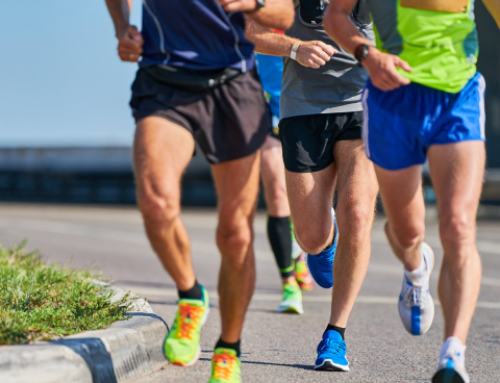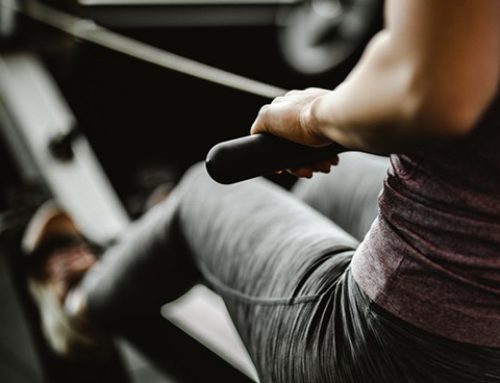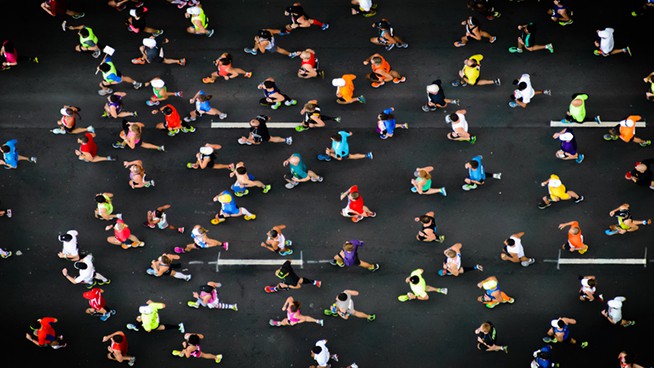Plyometrics for Runners: Master Class
Athletes in speed-based sports absolutely must perform plyometrics. For a plyometric exercise to be running-specific, it needs to focus on the posterior chain (the large muscles on the back of the body, such as the glutes, hamstrings and calves) and to isolate the muscular stretch-shortening cycle, the basis for all running actions.
This is a short and simple, progressive workout that can be done regularly to improve speed without affecting sport-specific training. Overall, the workout takes just over 30 minutes. The number of repetitions increases each week, but rest time is reduced, for an appropriate training progression. (Make sure you know how to safely progress with plyos.)[youtube video=”detO7R794zQ” /]
If you start from the right place, you’ll gain a significant boost in your performance without interfering with your regular training. The full progression need only be done once a year to achieve maximum effect and to make a significant impact on your running strength and speed.
Plyometrics for Runners Guidelines
- It’s important that the exercises not be performed to fatigue. Each rep must be as good as the first. If it isn’t, the number of reps is too high for that particular exercise.
- Do a short warm-up of your choice. Perform explosive exercises. Your lower legs, calves and hamstrings need to have blood pumping through them before you begin your workout. I usually get my athletes to skip rope for 10 minutes.
- Due to their high intensity, these exercises must be separated from other workouts.
- Recovery is fairly swift. If the exercises are done in the morning, they will not affect other training in the afternoon or evening.
- Do three blocks of four weeks with one week off between each block, for a total of 14 weeks (including rest weeks), in pre-season or early season only.
Plyometrics for Runners Exercises
See chart at bottom for set and rep progressions.
Rocket Jump
- Using a pre-load or bouncing down before jumping, leap explosively as high as possible using arms to increase height
- If possible, use a reference point, such as by touching a spot on a wall to make sure each rep is the same height
- On landing, immediately jump again
- Keep landing fairly stiff, without lots of knee and hip flexion; speed of response is what’s important here.
Partner Glute Ham Raise (or Glute Ham Dip)
- Either use a partner to hold your feet, or hook them under a sit-up bar
- With spine and thighs in straight line, use glutes and hamstrings to lower body to low push-up position
- Using arms to start the movement, raise body back up to vertical without bending at the hips
- Initially you will use your arms actively, but as strength increases, this will lessen
Single Leg Calf Jump Curls
- Stand on right leg with left ankle tucked under left buttock
- Explosively drive off floor and kick right heel up to right buttock
- Land on right leg; left leg plays no part in the action
- As soon as right foot strikes floor, drive up again in a fairly stiff action, so that each subsequent rep is a reaction off floor
- Repeat starting on left leg
- Place one leg on stable platform around 45 cm high
- Drive off this leg to jump into air and land on platform on same leg
- Use rear leg for stability only; it plays no part in the movement
- Do not use rear leg to help bounce off floor for next repetition
- On landing, immediately drive back up again
Single Leg Rocket Jumps
- Standing on right leg, follow same movement as for Rocket Jumps, but keep other leg off ground throughout repetition
- Repeat standing on left leg
Plyometrics for Runners Exercise Protocol
Each week, the total number of reps increases by one and the amount of rest reduces by one or two seconds, so the total amount of work done increases as the time decreases.
RECOMMENDED FOR YOU
MOST POPULAR
Plyometrics for Runners: Master Class
Athletes in speed-based sports absolutely must perform plyometrics. For a plyometric exercise to be running-specific, it needs to focus on the posterior chain (the large muscles on the back of the body, such as the glutes, hamstrings and calves) and to isolate the muscular stretch-shortening cycle, the basis for all running actions.
This is a short and simple, progressive workout that can be done regularly to improve speed without affecting sport-specific training. Overall, the workout takes just over 30 minutes. The number of repetitions increases each week, but rest time is reduced, for an appropriate training progression. (Make sure you know how to safely progress with plyos.)[youtube video=”detO7R794zQ” /]
If you start from the right place, you’ll gain a significant boost in your performance without interfering with your regular training. The full progression need only be done once a year to achieve maximum effect and to make a significant impact on your running strength and speed.
Plyometrics for Runners Guidelines
- It’s important that the exercises not be performed to fatigue. Each rep must be as good as the first. If it isn’t, the number of reps is too high for that particular exercise.
- Do a short warm-up of your choice. Perform explosive exercises. Your lower legs, calves and hamstrings need to have blood pumping through them before you begin your workout. I usually get my athletes to skip rope for 10 minutes.
- Due to their high intensity, these exercises must be separated from other workouts.
- Recovery is fairly swift. If the exercises are done in the morning, they will not affect other training in the afternoon or evening.
- Do three blocks of four weeks with one week off between each block, for a total of 14 weeks (including rest weeks), in pre-season or early season only.
Plyometrics for Runners Exercises
See chart at bottom for set and rep progressions.
Rocket Jump
- Using a pre-load or bouncing down before jumping, leap explosively as high as possible using arms to increase height
- If possible, use a reference point, such as by touching a spot on a wall to make sure each rep is the same height
- On landing, immediately jump again
- Keep landing fairly stiff, without lots of knee and hip flexion; speed of response is what’s important here.
Partner Glute Ham Raise (or Glute Ham Dip)
- Either use a partner to hold your feet, or hook them under a sit-up bar
- With spine and thighs in straight line, use glutes and hamstrings to lower body to low push-up position
- Using arms to start the movement, raise body back up to vertical without bending at the hips
- Initially you will use your arms actively, but as strength increases, this will lessen
Single Leg Calf Jump Curls
- Stand on right leg with left ankle tucked under left buttock
- Explosively drive off floor and kick right heel up to right buttock
- Land on right leg; left leg plays no part in the action
- As soon as right foot strikes floor, drive up again in a fairly stiff action, so that each subsequent rep is a reaction off floor
- Repeat starting on left leg
- Place one leg on stable platform around 45 cm high
- Drive off this leg to jump into air and land on platform on same leg
- Use rear leg for stability only; it plays no part in the movement
- Do not use rear leg to help bounce off floor for next repetition
- On landing, immediately drive back up again
Single Leg Rocket Jumps
- Standing on right leg, follow same movement as for Rocket Jumps, but keep other leg off ground throughout repetition
- Repeat standing on left leg
Plyometrics for Runners Exercise Protocol
Each week, the total number of reps increases by one and the amount of rest reduces by one or two seconds, so the total amount of work done increases as the time decreases.












